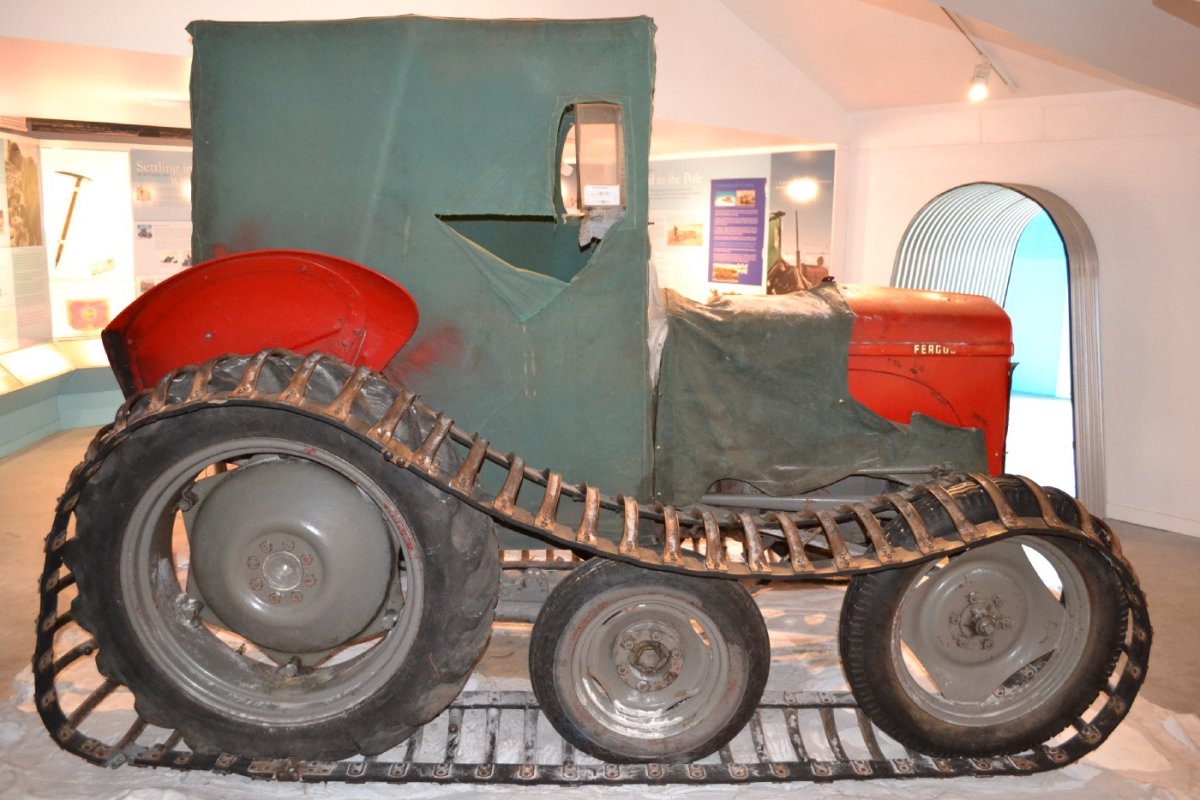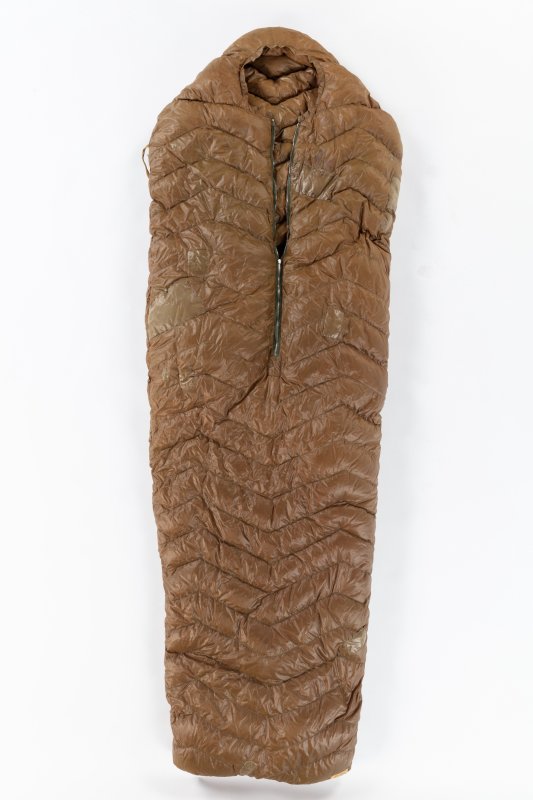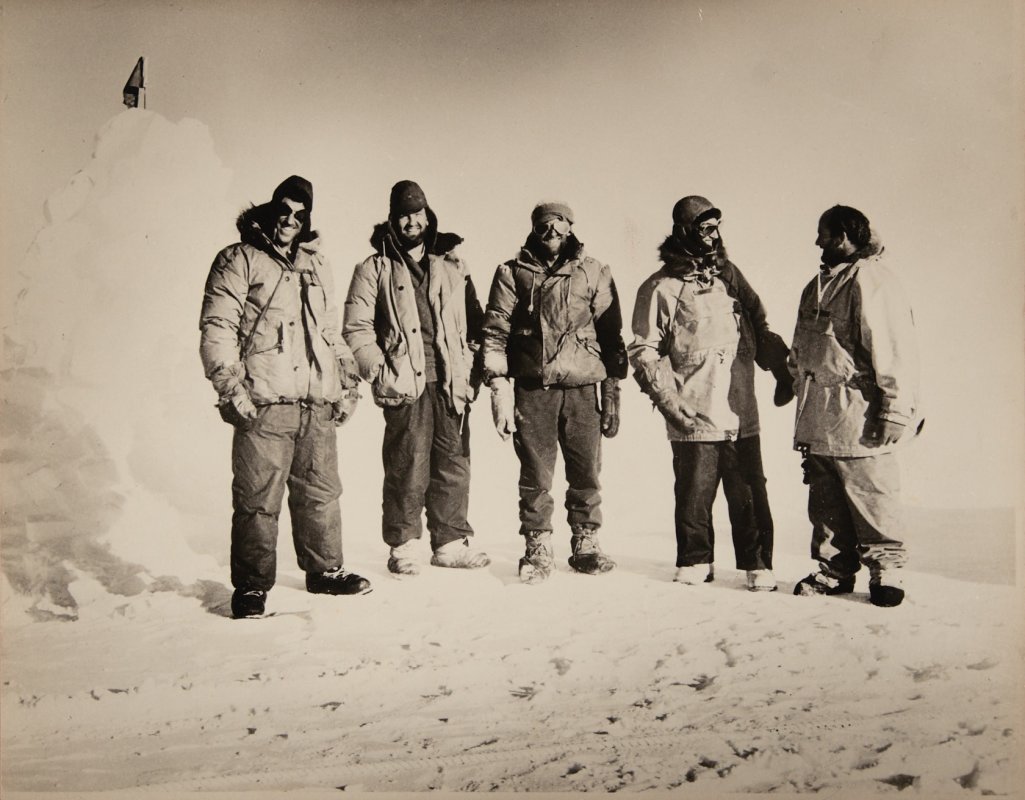To the South Pole — On a Farm Tractor

On 14 October 1957, a team of Kiwi men set off from New Zealand’s newly built Scott Base on three modified farm tractors and a Weasel snow vehicle in support of the Commonwealth
Trans-Antarctic Expedition’s attempt to cross the Antarctic continent via the South Pole.
Led by Sir Edmund Hillary, these tractors were a vital part of the crossing attempt, along with four dog sledding teams and airborne support from a Beaver aircraft.
The New Zealand party was responsible for setting depots that would provide essential supplies of food and fuel for Sir Vivian Fuchs’ party, who began the demanding traverse from
Britain’s Shackleton Base on the other side of the continent on 24 November 1957, and for laying a trail for Fuchs’ party to follow on the final leg of their journey to Scott Base. The Trans-Antarctic Expedition was not just an attempt to make the first overland crossing of the frozen continent. Fuchs, a British geologist, wanted to establish whether the Antarctic continent was one, or in fact, two continents, with scientists among the expedition members and significant research was to be carried out.

Route of Commonwealth Trans-Antarctic Expedition. CREDIT: Kikos, Wikimedia
Permanent national bases on the continent had not yet been established, and the last attempt to cross it had been made in 1914, when Sir Ernest Shackleton’s ship, the Endurance became trapped in sea ice before reaching Antarctica, stranding his party for months before their eventual rescue. One similarity between this expedition and the later Commonwealth expedition was the involvement of a second party to lay supply depots for the crossing party to access on the last leg of the journey. This element of Shackleton’s expedition was more successful, with three depots laid, although unused and at the cost of three team members’ lives.
The Frozen, Uncharted Continent
The Antarctic continent is one of the least hospitable environments on Earth; bitterly cold, exceptionally windy and dry with highly variable weather patterns. Fuchs approached Sir Edmund Hillary in November 1953, following his successful summiting of Mt Everest in May that year. For Hillary the adventurer, this proposed expedition was a great opportunity to explore the frozen continent, further pushing boundaries he’d already smashed in his conquest of Everest.
From the beginning, however, the adventure was underpinned by scientific discovery. In May 1955, when the New Zealand Government committed to the Trans-Antarctic Expedition, one of the outcomes was to be the establishment of a base in the Ross Sea area, from which scientific research could be undertaken as part of the International Geophysical Year 1957–58, focused on the polar regions. Responsibility for building the base fell under Hillary when he accepted command of both the New Zealand Trans-Antarctic Expedition and International Geophysical Year parties. The New Zealand Government established the Ross Sea Committee which organised New Zealand’s involvement in the expedition, including providing instruction to Hillary on his party’s tasks, and Fuchs was the overall leader of the Commonwealth expedition. When the New Zealand parties, including members who were to leave Antarctica at the end of summer and others who would stay on through winter, arrived in Antarctica in the summer of 1957, among their number were five International Geophysical Year personnel. Observations were made covering “meteorology, geomagnetism, aurorae, seismology, gravity,” along with fish stocks, tides and currents, and significant surveying was undertaken, improving the mapping of the previously largely uncharted continent.
The Ferguson Tractors
Five Ferguson TE-20 tractors were brought south with the New Zealand party, painted bright red rather than the factory grey to allow them to be more easily seen in the Antarctic landscape, especially from the air. One of these is now a much-treasured part of MOTAT’s collection, with a second in the Canterbury Museum collection. Fuchs had originally planned for the New Zealanders to have two tractors; however, after testing out a Ferguson tractor in snowy conditions, Hillary saw the usefulness of the tractors for his expedition and set about both sourcing more and learning all he could about their use and limitations on snow and ice.

Massey Ferguson TE20 tractor [1964.228] Museum of Transport and Technology (MOTAT)
The first use of Ferguson tractors in Antarctica was in 1954 by the Australian team establishing the continent’s first permanent base, and there had also been significant work done in Norway on converting the tractors for use in snow. The British party was to use Tucker Sno-Cats, specially developed for use on snow, as their principal vehicles. However, the New Zealand funding didn’t stretch this far, a fact Hillary was keenly aware of. On his return to England after that first trip to Antarctica, Hillary pushed to get to Norway, taking the expedition’s engineering officer to visit Ferguson’s agents there. Here they “ploughed through soft snow and over hard ice in half-tracks and full-tracks…discussed modifications and technical improvements; and generally gained a great deal of operational information.” Three tractors were eventually sourced directly through the British manufacturers and an additional two from Ferguson’s New Zealand agents.

Massey Ferguson TE20 tractor [1964.228] on display at MOTAT in “90° South — Sir Edmund Hillary and the NZ Antarctic Expedition 1956–8”, 2011. Museum of Transport and Technology (MOTAT)
In August 1956 Hillary gathered all the expedition members, including the dog teams, pilots and the tractor party, at the Tasman Glacier for a month’s training, which included driving practice with the Ferguson tractors, the dogs and sleds, and general acclimatisation to the kinds of conditions that could be expected in Antarctica. Dog teams were reliable and proven in Antarctica whereas tractors, previously only used for unloading ships and other work around Shackleton and Mawson bases, hadn’t been tested over the long distances Hillary was proposing. All the men practised driving the two Ferguson tractors, including towing loads, until they were all competent.

Sir Edmund Hillary prepares for the Commonwealth Trans-Antarctic Expedition. CREDIT: The Evening Post
On to Antarctica
The HMNZS Endeavour sailed for Antarctica in December 1956 with the New Zealand summer and winter parties onboard; the summer party tasked with the construction of Scott Base before their return to New Zealand. The ship arrived in McMurdo Sound on 4 January 1957. Over the next few days, expedition members set out on the tractors, with both half and full tracks on the wheels, and with dog teams to the site first proposed for Scott Base at Butter Point. The going was difficult, and accessibility issues meant the site was unsuitable for a permanent base, which needed to be accessible by both ship and aircraft. Further surveying, along with helicopter support from the Americans at McMurdo Station, established the previous summer, led to the identification of Pram Point as the better site for New Zealand’s Antarctic base. The tractors were used to transport the cargo, including the materials for Scott Base, loaded on sleds from the Endeavour across to the new base site at Pram Point. During this time, an early problem with the tractors was identified, with the tracks, crucial for driving on Antarctic surfaces, occasionally coming off. Jim Bates, the party’s diesel mechanic, was able to largely solve this with a few modifications to improve the tracks’ attachment and the tractors passed their first test.
The new site, while well situated for the Trans-Antarctic Expedition party, was not as advantageous for the scientists in the party, with magnetic forces from Mt Erebus and the volcanic rock around the base. In January, however, the base was built, and scientific research programmes commenced. In February the Endeavour and the summer party left, and the 23-member winter-over party settled into Scott Base for the dark Antarctic winter.
Before winter set in, Hillary wanted to further test the tractors over the local terrain and in March, he, Bates, Murray Ellis, engineer, and Peter Mulgrew, radio operator, set out with two tractors, each towing two loaded sledges, for Cape Crozier, about 80 kilometres from Scott Base. As with the unloading and transporting of cargo, the tractors in general proved their reliability and ruggedness on this trip, although the increased use of fuel in soft snow was identified, along with modifications and improvements the team wanted to make. During the winter, Ellis, an engineer, and Bates worked on three of the Fergusons to prepare them for the summer’s journey, overhauling them completely. The TE-20 models used in Antarctica had been fitted out at the Coventry factory with several non-standard parts; an additional wheel on each side for the tracking system, heavy-duty batteries and starter motors, insulation on the electrical wiring and, in addition to introducing oils and coolants designed for extreme temperatures, “As a further measure to keep the cooling system from freezing, the fan was reversed to blow warm air from the engine through the radiator instead of sucking in cold air.” Modifications were also made to the steering.
In the garage at Scott Base, Ellis and Bates constructed crash bars over the driver’s seat, as the tractors frequently sank into crevasses, and added roofless canvas cabs, as seen on the MOTAT tractor, to protect the driver from strong Antarctic winds, which also allowed them to stand for a better view. The tracks and tracking system were also worked on further to improve the tractors’ performance on soft snow, where they were least effective. On the Cape Crozier trip, the four men had taken turns driving with the sledges used as an exposed and uncomfortable rest spot. Hillary wasn’t happy with this for the longer trip and his winter projects included constructing a "caboose" that could be towed either by a tractor or the Weasel. The caboose was essentially a small hut on skis, equipped with bunks, cupboards, a cooking bench and radio equipment, which provided a more comfortable resting space, protected from the wind and even able to be heated!

Hillary with Rear-Admiral George Dufek at Scott Base, just before departure. CREDIT: The Weekly News and The New Zealand Herald - Weekly News
The Real Test
On 14 October 1957, the tractor team started out from Scott Base. The team remaining at the base and the Americans at McMurdo gave the tractors little chance of completing their journey. The tractors, although modified at the factory and further in Antarctica, simply were not designed for the extreme cold and challenging terrain. The engineer’s use of blow torches to thaw frozen fuel in the tank and lines on the Cape Crozier trip highlighted the challenge the tractors would face from the conditions.

Converted Ferguson TE20 tractors used by Edmund Hillary's team. CREDIT: Cliff Dickey, electronics technician, U.S. Navy, and the National Science Foundation
The initial team of four drivers was Hillary, Mulgrew, Ellis and Ron Balham, a biologist and meteorologist. The three Ferguson tractors were accompanied by a Weasel lent by the American Operation Deep Freeze based at McMurdo Station, and they were followed by two dog teams, with the two other dog teams later airlifted to meet them at the site of the first depot. The journey from Scott Base to the last depot, Depot 700 (D700), and then the additional leg for the tractors on to the South Pole was a total of 2,000kms. It was not an easy journey as crevasses were unavoidable and frequently slowed the journey, fraying nerves. Despite investigating and marking seemingly safe routes through stretches of crevasses, the tractors could still get caught unexpectedly as a snow bridge crumpled beneath their weight. Repair work was also frequently needed on the tractors, including to the tracks.
The altitude of the Polar Plateau, at 2,700 metres above sea level, and the climate, with an average temperature on the Plateau of -45°C, put additional strain on the tractors and the men. A hot-air blower was used on occasion to pre-heat the tractor engines before they could be started, and the caboose was invaluable in providing a respite from the conditions.
For Hillary and Mulgrew it also provided a somewhat comfortable sleeping accommodation, while the others slept in a British-issue polar tent. Hillary had used sleeping bags made by Dunedin-based Arthur Ellis & Co on Mount Everest and was satisfied enough with their warmth and weather proofness to take the company’s sleeping bags on the Trans-Antarctic Expedition also. The Fairydown-branded sleeping bags were filled with goose down with a nylon outer layer. The bag then slipped inside an additional sleeping bag cover and lining, with another layer of goose down and a heavy orange cotton outer. Derek Wright’s sleeping bag, cover and liner are now in the MOTAT collection.

Fairydown Sleeping Bag [2017.23.25] Museum of Transport and Technology (MOTAT)
Demand for warm waterproof sleeping bags like Wright’s was originally driven by explorers in the late 1800s. Ellis & Co, founded by Murray Ellis’ great-grandfather, made the Southern Hemisphere’s first down sleeping bag in 1920. Goose down, the soft feathers underneath the bird’s tougher outer feathers, is a natural insulator, trapping heat in the pockets of air created by the structure of the down. The layers of goose down in the sleeping bags kept the men’s body warmth close to them rather than allowing it to escape during the cold Antarctic nights, and days, as the sleeping bags were not used solely at night with the tractor party often travelling at night and in turn slept during the day. The layers of nylon and thick cotton would have helped keep the sleeping bag dry as, when wet, the down loses its insulating properties.

Fairydown Sleeping Bag Cover and Cover Lining [2017.23.26] Museum of Transport and Technology (MOTAT)
Farm Tractors for the Win
D700 was the last of the depots stocked by Hillary’s party, and from here he sent a message to Fuchs advising the party would now attempt to reach the South Pole. But Fuchs’ party were making slow progress from the other side of the continent and were behind schedule, which meant that Hillary’s tractor party, now comprising Hillary, Ellis, Mulgrew, Bates and Wright, would undoubtedly reach the Pole before them. The Ross Sea Committee advised Hillary he was not to travel further than D700 and separately Fuchs also asked Hillary to abandon his journey from D700 to the Pole, although by then Hillary had already started, so fuel and supplies were already committed. Crevasses were still taking their toll and the conditions, including soft snow, were such that the tractors were using a lot of fuel, requiring the party to abandon all non-essential supplies to reduce the weight the tractors were pulling. The Weasel had broken down beyond repair and been abandoned, and navigation was also an issue, with the bubble sextant proving inaccurate as the party ascended.

Edmund Hillary, Murray Ellis, Jim Bates, Peter Mulgrew, and Derek Wright at Depot 700. Derek Wright Collection [PHO-2017–2] Museum of Transport and Technology (MOTAT)
On 4 January 1958, however, there was jubilation amongst the men when their party finally arrived at the American station at the South Pole and the New Zealanders, and their three modified farm tractors, became the first overland expedition to reach the South Pole since Captain Robert Falcon Scott in 1912.

Sir Edmund Hilary with tractors at the South Pole. CREDIT: Te Ara Encyclopedia of New Zealand
Story by Nicola Jennings, Collection Researcher, MOTAT
Links:
MOTAT Collection Images:
Massey Ferguson TE20 tractor [1964.228] Museum of Transport and Technology (MOTAT)
Fairydown Sleeping Bag [2017.23.25] Museum of Transport and Technology (MOTAT)
Fairydown Sleeping Bag Cover and Cover Lining [2017.23.26] Museum of Transport and Technology (MOTAT)
Edmund Hillary, Murray Ellis, Jim Bates, Peter Mulgrew, and Derek Wright at Depot 700. Derek Wright Collection [PHO-2017–2] Museum of Transport and Technology (MOTAT)
MOTAT Collections Online: Sir Edmund Hillary
GearJunkie: “Down Vs. Synthetic: Understanding Sleeping Bag Insulation."
Current Weather, McMurdo, Antarctica
Citation:
Jennings, Nicola. To the South Pole — On a Farm Tractor. MOTAT Museum of Transport and Technology. First published: 2 February 2022. URL: https://www.motat.nz/collections-and-stories/stories/to-the-south-pole-on-a-farm-tractor